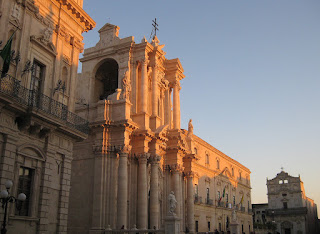After another tequila sunrise and excellent breakfast at my hotel I found another route to the Museo Archeologico and beyond it to the Parco Archeologico della Neapolis, where the Teatro Greco was located, and it was quite simple to get to both. I stopped momentarily at the Museo Archeologico, from which spot you are not likely to miss the gigantic and rather bizarre looking church called the
 |
| Santuario della Madonna delle Lachrime |
I decided that it would be better to see the Parco before looking through the museum and headed off in that direction, finding it more quickly and easily than I'd ever have thought. In fact it was much more difficult to find the box office for the parco, as it is located across a very busy road, and then not well marked. Once across the road you have to get past some very tacky tourist stands, and then off in the distance there's a building that can only be the box office, as that's all that's left in the area. Sure enough it was, I quickly bought a ticket, escaped the tourist stands, very carefully crossed the road and found myself in the Parco Archeologico.
 |
| Anfiteatro Romano |
 |
| Ara di Ierone II |
Next to the amphitheatre is located a site sealed off from the public, but where what looked to be a group of archeological students working the morning I visited, called the Ara di Ierone II. This is a gigantic altar, 200 meters in length, built in the late third century BC, the longest of any in all of Magna Graecia. Apparently for the annual celebration 450 bulls were led up ramps to the altar, to be slaughtered for the feast.
The star attraction of the park is the very popular tourist spot the Teatro Greco.
 |
| Teatro Greco |
After I'd had my fill of the theatre I wandered through the quarries, which are now grown over with lemon and orange trees, quite lovely. And then I left the Parco Archeologico, after a morning I considered very well-spent.
Next stop was the Museo Archeologico, a very impressive museum focusing on local Siracusan artifacts from pre-history through the Greco-Roman period,
 |
| Museo Archeologico |
 |
| The lovely park where I ate my lunch |
 |
| Teatro dei Pupi |
 |
| Museo Aretuseo dei Pupi |
And then I had another wander, as I needed to buy oostcards, and ended in a shop/cafe that featured local treats. I decided on an aperitivo there, was given one similar to and every bit as delicious as the one I'd had the day before, and with it a plateful of local snacks, which I enjoyed while writing out the postcards I'd just bought in their shop.
 |
| My yummy aperitivo! |
 |
| The Duomo just before sunset |
The best you could say for the restaurant, called the Luna Rossa, was its location. It was on that promenade near the Fonte Aretusa and even after sunset it was warm enough to sit outside and gaze out across the continually darkening bay. While not all the food was perfect, my last night in Siracusa was not all that bad.
The next day, one last sunrise, one last breakfast, and I was on my way to the rail station to catch the train to Catania. A bit about that rather different city in my last post about Sicily!


No comments:
Post a Comment